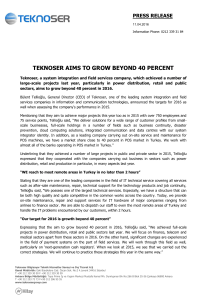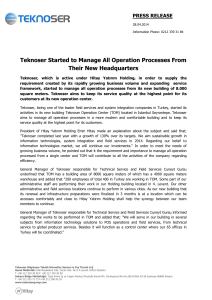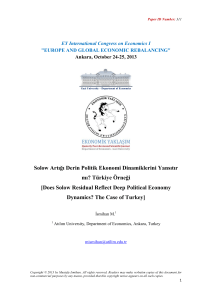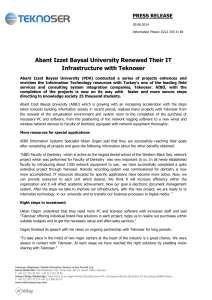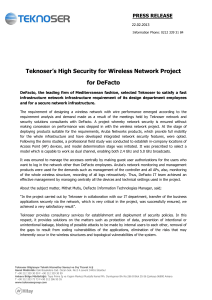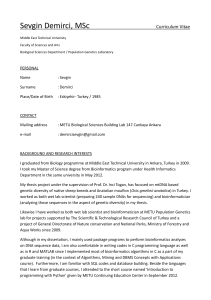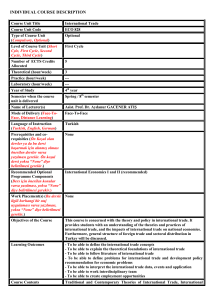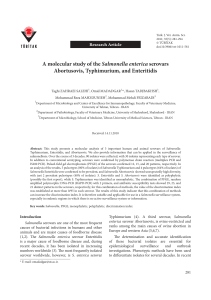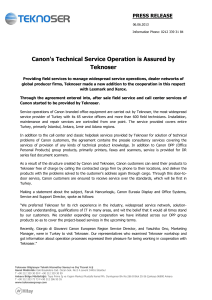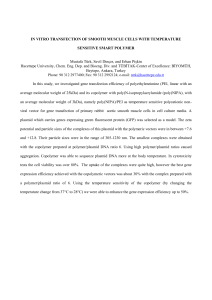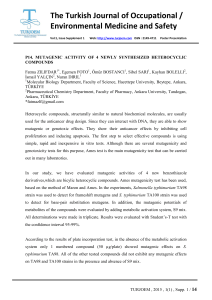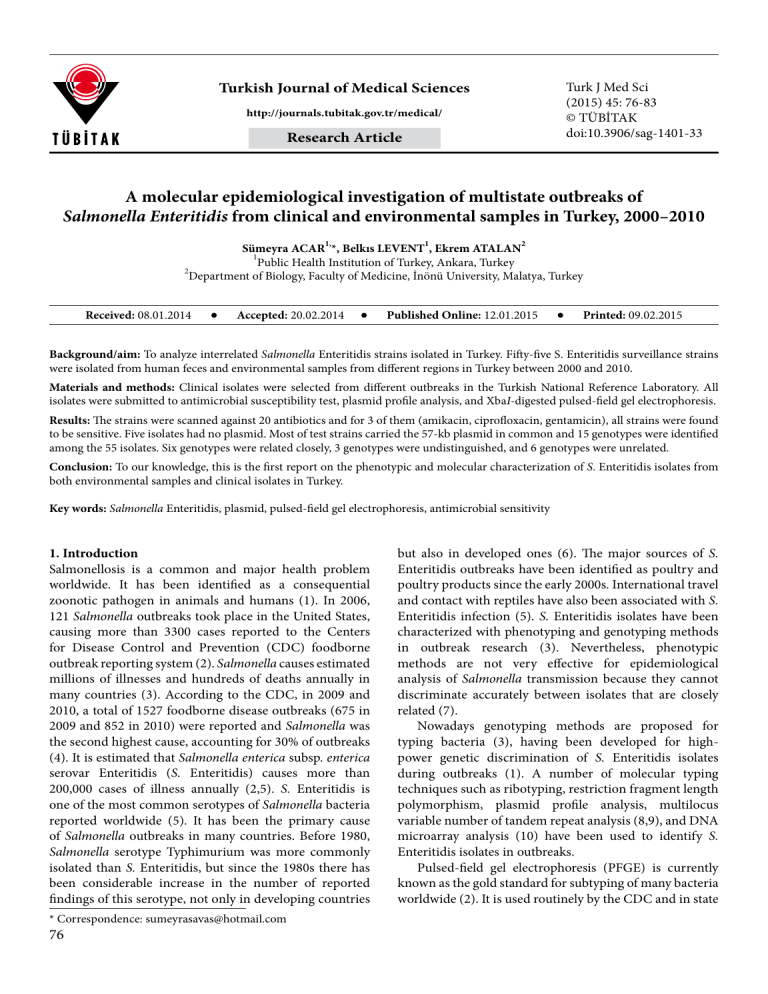
Turkish Journal of Medical Sciences
Turk J Med Sci
(2015) 45: 76-83
© TÜBİTAK
doi:10.3906/sag-1401-33
http://journals.tubitak.gov.tr/medical/
Research Article
A molecular epidemiological investigation of multistate outbreaks of
Salmonella Enteritidis from clinical and environmental samples in Turkey, 2000–2010
1,
1
2
Sümeyra ACAR *, Belkıs LEVENT , Ekrem ATALAN
1
Public Health Institution of Turkey, Ankara, Turkey
2
Department of Biology, Faculty of Medicine, İnönü University, Malatya, Turkey
Received: 08.01.2014
Accepted: 20.02.2014
Published Online: 12.01.2015
Printed: 09.02.2015
Background/aim: To analyze interrelated Salmonella Enteritidis strains isolated in Turkey. Fifty-five S. Enteritidis surveillance strains
were isolated from human feces and environmental samples from different regions in Turkey between 2000 and 2010.
Materials and methods: Clinical isolates were selected from different outbreaks in the Turkish National Reference Laboratory. All
isolates were submitted to antimicrobial susceptibility test, plasmid profile analysis, and XbaI-digested pulsed-field gel electrophoresis.
Results: The strains were scanned against 20 antibiotics and for 3 of them (amikacin, ciprofloxacin, gentamicin), all strains were found
to be sensitive. Five isolates had no plasmid. Most of test strains carried the 57-kb plasmid in common and 15 genotypes were identified
among the 55 isolates. Six genotypes were related closely, 3 genotypes were undistinguished, and 6 genotypes were unrelated.
Conclusion: To our knowledge, this is the first report on the phenotypic and molecular characterization of S. Enteritidis isolates from
both environmental samples and clinical isolates in Turkey.
Key words: Salmonella Enteritidis, plasmid, pulsed-field gel electrophoresis, antimicrobial sensitivity
1. Introduction
Salmonellosis is a common and major health problem
worldwide. It has been identified as a consequential
zoonotic pathogen in animals and humans (1). In 2006,
121 Salmonella outbreaks took place in the United States,
causing more than 3300 cases reported to the Centers
for Disease Control and Prevention (CDC) foodborne
outbreak reporting system (2). Salmonella causes estimated
millions of illnesses and hundreds of deaths annually in
many countries (3). According to the CDC, in 2009 and
2010, a total of 1527 foodborne disease outbreaks (675 in
2009 and 852 in 2010) were reported and Salmonella was
the second highest cause, accounting for 30% of outbreaks
(4). It is estimated that Salmonella enterica subsp. enterica
serovar Enteritidis (S. Enteritidis) causes more than
200,000 cases of illness annually (2,5). S. Enteritidis is
one of the most common serotypes of Salmonella bacteria
reported worldwide (5). It has been the primary cause
of Salmonella outbreaks in many countries. Before 1980,
Salmonella serotype Typhimurium was more commonly
isolated than S. Enteritidis, but since the 1980s there has
been considerable increase in the number of reported
findings of this serotype, not only in developing countries
*Correspondence: [email protected]
76
but also in developed ones (6). The major sources of S.
Enteritidis outbreaks have been identified as poultry and
poultry products since the early 2000s. International travel
and contact with reptiles have also been associated with S.
Enteritidis infection (5). S. Enteritidis isolates have been
characterized with phenotyping and genotyping methods
in outbreak research (3). Nevertheless, phenotypic
methods are not very effective for epidemiological
analysis of Salmonella transmission because they cannot
discriminate accurately between isolates that are closely
related (7).
Nowadays genotyping methods are proposed for
typing bacteria (3), having been developed for highpower genetic discrimination of S. Enteritidis isolates
during outbreaks (1). A number of molecular typing
techniques such as ribotyping, restriction fragment length
polymorphism, plasmid profile analysis, multilocus
variable number of tandem repeat analysis (8,9), and DNA
microarray analysis (10) have been used to identify S.
Enteritidis isolates in outbreaks.
Pulsed-field gel electrophoresis (PFGE) is currently
known as the gold standard for subtyping of many bacteria
worldwide (2). It is used routinely by the CDC and in state
ACAR et al. / Turk J Med Sci
health departments in Latin America, Asia, and the United
States (1). The efficacy of PFGE regarding discrimination
and epidemiological characterization of S. Enteritidis
strains has been proven (2).
To our knowledge, this is the first study on antimicrobial
resistance and molecular characterization of S. Enteritidis
from environmental samples sourced from poultry farms
and humans in Turkey. The purpose of this study was to
determine and compare antimicrobial resistance, plasmid
profiling, and PFGE patterns of related S. Enteritidis
strains isolated from different geographical area during the
period from 2000 to 2010. The present study is an attempt
to help the surveillance of antimicrobial resistance status
between 2000 and 2010 in Turkey.
2. Materials and methods
2.1. Bacterial strains
A total of 55 S. Enteritidis strains were studied. These
strains were isolated from human feces (46) and
environmental samples (9) from 9 different cities in Turkey
from 2000 through 2010. These strains were selected from
the collection of the Public Health Institution of Turkey,
National Reference Laboratory for Enteric Pathogens.
Isolates were systematically chosen to represent isolates
from outbreaks and environmental samples that occurred
during different years. Table 1 lists the year and the
isolation source of the 55 S. Enteritidis strains used in this
study.
2.2. Antimicrobial susceptibility testing
Antimicrobial susceptibilities for S. Enteritidis isolates
were determined by the standard disk diffusion method
in Mueller-Hinton agar in accordance with Clinical and
Laboratory Standards Institute guidelines. All strains
were tested for resistance to the following 20 antibiotics
(Oxoid, UK): ampicillin (AMP) (10 µg), gentamicin
(GN) (10 µg), amoxicillin-clavulanic acid (AMC) (25
µg), cefuroxime sodium (CXM) (30 µg), cefoperazone
(CFP) (30 µg), cefotaxime (CTX) (30 µg), ceftizoxime
(ZOX) (30 µg), ceftriaxone (CRO) (30 µg), ceftazidime
(CAZ) (30 µg), sulfamethoxazole/trimethoprim (SXT)
(25 µg), chloramphenicol (C) (30 µg), tetracycline (TE)
(10 µg), kanamycin (K) (30 µg), nalidixic acid (NA) (30
µg), ciprofloxacin (CIP) (5 µg), sulfonamides (S3) (30 µg),
streptomycin (S10) (10 µg), trimethoprim (W) (25 µg),
cefpodoxime (CPD) (10 µg), and amikacin (AK) (30 µg).
E. coli ATCC 25922 was used as the quality control strain.
Table 1. Plasmid types and molecular sizes of all isolates.
Strains
Plasmid patterns (kb) Plasmid types
Number of strains Percentage of strains
2, 3, 12, 14, 15, 17, 19, 20, 28, 18, 34, 41, 42, 46, 32 57; 3, 7
Type 1
15
27.20%
4, 7, 8, 9, 22, 25, 43, 44, 49
57; 5
Type 2
9
16.3%
5
67; 3,7
Type 3
1
1.81%
6, 13, 14
57; 3,7; 3,4
Type 4
1
5.4%
10
67; 5; 3,7; 3,4
Type 5
1
11, 40, 53, 55, 51, 54
57
Type 6
6
10.9%
29
57; 5; 4
Type 7
1
1.81%
35, 39, 38
57; 1, 5
Type 8
3
5.4%
45
57; 3, 4
Type 9
1
1.81%
23
90; 57; 9; 3, 4
Type 10
1
1.81%
16
67; 7
Type 11
1
1.81%
37
3, 7
Type 12
1
1.81%
36
67; 57
Type 13
1
1.81%
24
67; 1, 5
Type 14
1
1.81%
26
67; 57; 4; 3, 4
Type 15
1
1.81%
31
67
Type 16
1
1.81%
33
67; 5
Type 17
1
1.81%
30
67; 3, 4
Type 18
1
1.81%
21
2, 8
Type 19
1
1.81%
1, 27, 48, 50, 52
No plasmid
Type 20
5
9.09%
Total
55
1.81%
77
ACAR et al. / Turk J Med Sci
2.3. Plasmid DNA analysis
Plasmid DNA of each strain was extracted and purified
according to the method of Kado and Liu (10) with
modifications and determined by electrophoresis on 0.6%
agarose gel (Sigma-Aldrich, USA) containing 0.5 mL of
ethidium bromide with 1X Tris-borate-EDTA (TBE) buffer
at 110 V for 3.5 h. A large molecular marker, supercoiled
DNA ladder (Invitrogen, Carlsbad, CA), and E. coli 239
(147 kb, 63 kb, 36 kb) were used for determining plasmid
size. Control strains were acquired from the Public Health
Institution of Turkey, National Reference Laboratory for
Enteric Pathogens.
2.4. Pulsed field gel electrophoresis
Agarose blocks were prepared according to the CDC
Pulse Net protocol with some modifications (11). They
were digested with the restriction endonuclease XbaI
(Fermentas Life Sciences, Lithuania) overnight in a water
bath at 37 °C. Fragments were separated by electrophoresis
for 19.4 h at 6 V/cm with pulse times of 2.2–63.8 s and at
14 °C in 0.5X TBE buffer, and were electrophoresed with a
CHEF-DRII electrophoresis system (Bio-Rad, USA). The
gels were stained with ethidium bromide (2 mg/mL, Sigma)
for 25 min and then rinsed 3 times with distilled water for
15 min each and visualized with a UV transilluminator.
Photographed images were converted to TIFF files. The
band patterns were analyzed by BioNumerics (Applied
Maths, Inc., Belgium) software version 6.01. Cluster
analysis was obtained at 1% optimization and 1%
tolerance, and DNA relatedness was calculated based on
the Dice coefficient and unweighted pair group method
with averages (UPGMA). Salmonella Braenderup (H9812)
was used as a molecular weight marker for normalization.
The DNA banding patterns were interpreted as instructed
by Tenover et al. (12,13).
3. Results
3.1. Antimicrobial susceptibility test
The antimicrobial susceptibility of 55 S. Enteritidis strains
isolated from human and environmental samples were
determined. Table 2 summarizes the resistance of all S.
Enteritidis strains to 21 antimicrobial agents. Among
the strains, the highest levels of resistance were observed
for cefotaxime and ceftizoxime (12.7%); cefpodoxime
and ceftazidime (10.9%); sulfonamides and ampicillin
(5.45%); cefuroxime sodium, chloramphenicol, and
nalidixic acid (3.63%); and trimethoprim, streptomycin,
sulfamethoxazole-trimethoprim,
ceftriaxone,
and
cefoperazone (1.8%). Some of the isolates were found
to have lower resistance to cefuroxime sodium (10.9%);
tetracycline (5.45%); streptomycin, nalidixic acid,
ceftriaxone, and ampicillin (3.6%); and cefoperazone,
amoxicillin-clavulanic acid, ceftazidime, and kanamycin
(1.8%), but no strains were resistant to gentamicin,
ciprofloxacin, or amikacin.
78
In this study, multiresistance, the resistance to 2 or
more antimicrobials, occurred in 16 (29%) of the isolates,
and it seems that multiresistance in human S. Enteritidis
isolates is a problem for public health.
In Turkey epidemiological data were observed
identifying antimicrobial resistance of S. Enteritidis in 9
different cities, and all strains from Erzurum, Malatya,
Denizli, and Alanya were found susceptible to all drugs.
The highest level of resistance among the cities was found
in Kütahya and Ankara.
3.2. Plasmid DNA analysis
A total of 20 different plasmid profiles were observed
among the 55 S. Enteritidis isolates. They were identified
by their weight in kilobase pairs (kb). Fifty isolates had 1
to 6 plasmids with molecular sizes from 1.5 to 90 kb. Type
6 carried a single plasmid of approximately 57 kb (72.7%).
Ten distinct plasmid types carried this major plasmid,
along with others, while 9.1% of isolates were plasmidfree S. Enteritidis strains. Table 2 shows plasmid types
and molecular sizes for all isolates. Tested strains having
different antibiotic resistance patterns carried similar
plasmid profiles or their direct opposites. The data showed
that there was not a close relation between antibiotic
resistance and plasmids. It could be due to single genetic
event with a deletion, insertion, or point mutation on the
plasmids of isolates.
3.3. PFGE analysis
After the S. Enteritidis strains were examined by PFGE
method and cut with an XbaI macrorestriction enzyme,
a band ranging between 11 and 16 was obtained. Thirtyeight clinical isolates belonged to 3 pulsotypes (types 1, 2,
and 3) and had a similarity coefficient higher than 95%.
They were classified a clonally related to each other. Eleven
clinical isolates belonged to 6 pulsotypes (3A, 4, 4A, 5, 5A,
and 5B), and they were highly genetically homogeneous
and had more than 85% similarity. Six isolates belonged to
6 pulsotypes (types 6, 7, 8, 9, 10, and 11) and had unrelated
profiles. In addition, type 1 was found to be the most
prevalent in the environmental samples. These results
emphasized that ongoing transmission was very common
from human to human and from human to environment.
The Figure shows the results obtained by PFGE for S.
Enteritidis isolates and the phylogenetic tree of all isolates.
Recently, infections with type 1 of S. Enteritidis have been
predominant in Turkey.
Therefore, all strains that belonged to the dominant
S. Enteritidis profile (type 1) were cut with a second
macrorestriction enzyme (SpeI) for confirmation. All type
1 S. Enteritidis strains were confirmed as being the same
as each other.
4. Discussion
Salmonella infections are a global problem; the serotyping
of Salmonella strains posing a danger for public health
ACAR et al. / Turk J Med Sci
Table 2. Numbers of all Salmonella Enteritidis isolates with pulsed field gel electrophoresis (PFGE) type, antimicrobial resistance profile,
plasmid profile, origin, sources and dates.
Strain no. Source
Origin
Date
PFGE type
Plasmid type
Resistance to antibiotics
1
Feces
Düzce
2000
1
20
Sensitive to all
2
Feces
Düzce
2007
3
1
CTX, ZOX, CAZ
3
Feces
Erzurum
2004
1
1
Sensitive to all
4
Feces
Malatya
2002
1
2
Sensitive to all
5
Feces
Kütahya
2002
1
3
CFP, C, W
6
Feces
Ankara
2004
7
4
KF, ZOX, SXT
7
Feces
Ankara
2009
1
2
CAZ, CPD
8
Feces
Ankara
2009
1
2
CTX, CAZ, CPD
9
Feces
Ankara
2005
3
2
Sensitive to all
10
Feces
Ankara
2005
8
5
Sensitive to all
11
Feces
Ankara
2009
1
6
AMP, CXM, CTX, ZOX, TE
12
Feces
Ankara
2009
1
1
Sensitive to all
13
Feces
Ankara
2009
1
4
CAZ
14
Env. sample
Ankara
2009
1
4
Sensitive to all
15
Feces
Erzurum
2009
1
1
Sensitive to all
16
Env. sample
Ankara
2010
6
11
CIP, CPD
17
Feces
Erzurum
2009
1
1
Sensitive to all
18
Feces
Diyarbakır
2009
1
1
S3
19
Feces
Diyarbakır
2009
1
1
Sensitive to all
20
Feces
Erzurum
2009
1
1
Sensitive to all
21
Feces
Ankara
2009
1
19
Sensitive to all
22
Feces
Ankara
2005
10
2
S3, CPD
23
Feces
Malatya
2001
1
10
Sensitive to all
24
Feces
Alanya
2009
1
14
Sensitive to all
25
Feces
Ankara
2003
2
2
CRO
26
Feces
Ankara
2009
9
15
Sensitive to all
27
Feces
Ankara
2004
11
20
Sensitive to all
28
Feces
Alanya
2005
2
1
Sensitive to all
29
Feces
Diyarbakır
2009
1
7
Sensitive to all
30
Feces
Ankara
2004
10
18
C, CPD
31
Feces
Ankara
2005
4A
16
AMP, CTX, ZOX
32
Feces
Ankara
2009
1
1
Sensitive to all
33
Env. sample
Ankara
2009
1
17
CPD
34
Env. sample
Ankara
2009
1
1
Sensitive to all
35
Feces
Manisa
2009
1
8
Sensitive to all
36
Env. sample
Ankara
2009
1
13
C
37
Env. sample
Ankara
2009
1
12
Sensitive to all
38
Feces
Manisa
2009
1
8
CXM, CTX, ZOX
39
Feces
Manisa
2009
1
8
Sensitive to all
40
Feces
Denizli
2009
5A
6
Sensitive to all
41
Feces
Manisa
2009
1
1
Sensitive to all
79
ACAR et al. / Turk J Med Sci
Table 2. (Continued).
42
Env. sample
Ankara
2009
1
1
Sensitive to all
43
Feces
Kütahya
2009
1
2
K
44
Feces
Manisa
2009
1
2
CAZ
45
Feces
Kütahya
2009
5
9
S3, S10, CPD
46
Env. sample
Ankara
2009
1
1
CAZ
47
Feces
Diyarbakır
2009
1
7
CTX, ZOX, CAZ, CPD
48
Feces
Manisa
2009
5A
20
Sensitive to all
49
Env. sample
Ankara
2010
5A
2
CTX, ZOX
50
Feces
Ankara
2005
4
20
Sensitive to all
51
Feces
Ankara
2010
5A
6
AMP, CTX, ZOX
52
Feces
Manisa
2009
5A
20
CTX, ZOX
53
Feces
Denizli
2009
5B
6
Sensitive to all
54
Feces
Ankara
2002
1
6
Sensitive to all
55
Feces
Denizli
2009
5A
6
Sensitive to all
and the determination of antimicrobial sensitivities are
of importance epidemiologically (14). S. Enteritidis is
the second most common serovar seen in South America
and Oceania (15–18). It is the most common serovar seen
in other areas, including Turkey (19). It was reported by
the National Enteric Pathogens Reference Laboratory of
Turkey that 47% of human-based Salmonella strains in
2000–2002, 46% of human-based Salmonella strains in
2003–2005, and 79.4% of Salmonella strains isolated from
clinical samples and 26% of Salmonella strains obtained
from nonclinical isolates in 2010 were S. Enteritidis (20).
In this study, 55 S. Enteritidis strains isolated from
environmental and clinical samples were typed by means
of plasmid DNA profile and PFGE methods. Antimicrobial
resistance patterns of samples were examined in this study,
conducted over a long period and throughout Turkey.
Antibiotic resistance, which is increasing rapidly in
Salmonella species, is an important public health problem.
Castro et al. (21) examined 128 clinical S. Enteritidis
isolates between 1985 and 1999 and found that 0.8%
were resistant to nalidixic acid and 8.6% were resistant
to sulfamethoxazole/trimethoprim. Fernandes et al. (6)
found that 20.9% of 105 isolates were resistant to nalidixic
acid and 13.9% were resistant to sulfamethoxazole/
trimethoprim. In Turkey, Erdem et al. (22) determined
high resistance to chloramphenicol, ampicillin, and
sulfamethoxazole/trimethoprim antibiotics used in
Salmonella treatment. Between 2003 and 2005, it
was reported that 46% of 87 clinical and nonclinical
Salmonella isolates were S. Enteritidis, 5.7% of which
showed resistance to nalidixic acid (20,23), and it was
observed that nonclinical S. Enteritidis isolates were
resistant to gentamicin, streptomycin, nalidixic acid,
sulfamethoxazole/trimethoprim, and ampicillin. This
80
study covered the years between 2000 and 2010 years and an
increase was observed in clinical isolate resistance profile
in Turkey compared with previous years: 12% ceftizoxime,
12% ceftriaxone, and 10% ceftazidime resistance profiles
were observed. Similarity was found in the antibiotic
resistance profiles of environmental and clinical samples.
Environmental isolates in this study came to the National
Reference Enteric Laboratory for confirmation and typing
from poultry farms, and resistances in these strains may
have resulted from excess antibiotic usage for the purpose
of increasing growth, particularly in local production.
Antibiotics used in animals may lead to the development
of resistant pathogens infecting humans through the food
chain. For this reason, the use of antimicrobial agents in
humans and animals should be done with caution.
Plasmid profile analysis is a fast, simple, and cheap
molecular method used for the classification of epidemics
(22,24). However, in this study, it was determined that
while certain strains do not carry plasmids, the majority of
strains carry plasmids specific to the S. Enteritidis serotype
(57 kb), either singularly or with other plasmids. Since
many strains have similar plasmid profiles in Turkey, it was
concluded that plasmid profiles should be used together
with another molecular method in the monitoring of S.
Enteritidis epidemiology.
Further separation of epidemic strains is required, and
methods based on DNA fingerprint analysis have been
frequently used in recent years (22). PFGE is used in the
subtyping of the S. Enteritidis serotype and is accepted
as the gold standard among molecular methods (25). In
a prior study, repetitive extragenic palindromic basedPCR, enterobacterial repetitive intergenic consensus
sequence based-PCR, and Box-PCR were used together in
typing S. Enteritidis strains, but it was reported that this
ACAR et al. / Turk J Med Sci
Stratin No PFGE Tipi
Places
Date
Sources
70 80 90 100
82.1
76.8
92.9
75.1 82.6
72.8
69.4
86.2
99.6
96.3
95.5
68.0
95.2
90.4
60.7
89.6
82.3
92.3
96.8
St 16
6
ES ANKARA
2010
Env. Samp.
St 6
7
ANKARA
2004
FECES
St 50
4
ANKARA
2005
FECES
St 31
4A
ANKARA
2005
FECES
St
8
ANKARA
2005
FECES
St 26
9
ANKARA
2009
FECES
St
3
DÜZCE
2007
FECES
St 9
3
ANKARA
2005
FECES
St 22
3A
ANKARA
2005
FECES
St 30
10
ANKARA
2004
FECES
St 34
1
ESANKARA
2009
Env.Samp.
St 13
1
ANKARA
2009
FECES
St 41
1
MAN SA
2009
FECES
St 42
1
ES ANKARA
2009
Env.Samp.
St 46
1
ES ANKARA
2009
Env.Samp.
St 33
1
ES ANKARA
2009
Env.Samp.
St 44
1
MAN SA
2009
FECES
St 1
1
DÜZCE
2000
FECES
St 3
1
ERZURUM
2004
FECES
St 32
1
ANKARA
2009
FECES
St 24
1
ALANYA
2009
FECES
St 29
1
D YARBAKIR
2009
FECES
St 47
1
D YARBAKIR
2009
FECES
St 12
1
ANKARA
2009
FECES
St 15
1
ERZURUM
2009
FECES
St 17
1
ERZURUM
2009
FECES
St 19
1
D YARBAKIR
2009
FECES
St 18
1
D YARBAKIR
2009
FOOD .
St 14
1
ES ANKARA
2009
Env.Samp.
St 21
1
ANKARA
2009
FECES
St 36
1
ESANKARA
2009
Env.Samp.
St 37
1
ES ANKARA
2009
Env.Samp.
St 43
1
KÜTAHYA
2009
FECES
St 39
1
MAN SA
2009
FECES
St 38
1
MAN SA
2009
FECES
St 35
1
MAN SA
2009
FECES
St 54
1
ANKARA
2002
FECES
St 8
1
ANKARA
2009
FECES
St 4
1
MALATYA
2002
FECES
St 7
1
ANKARA
2009
FECES
St 23
1
MALATYA
2001
FECES
St 11
1
ANKARA
FECES
ST 20
1
ERZURUM
2009
2009
St 5
1
KÜTAHYA
2002
FECES
St 45
5
KÜTAHYA
2009
FECES
St 40
5A
DEN ZL
St 48
5A
MAN SA
St 52
5A
MAN SA
St 55
5A
DEN ZL
St 51
5A
ANKARA
10
2
St 49
5A
ES ANKARA
St 53
5B
DEN ZL
St 28
2
ALANYA
St25
2
ANKARA
ST 27
11
ANKARA
FECES
2009
FECES
2009
FECES
2009
FECES
2009
FECES
2010
FECES
2010
Env.Saples
2009
FECES
2005
FECES
2003
FECES
2004
FECES
Figure. Dendrogram generated using the Dice coefficient based on PFGE profiles of the 55 Salmonella Enteritidis isolates
restricted with XbaI, constructed using UPGMA.
81
ACAR et al. / Turk J Med Sci
did not find an effective difference for S. Enteritidis (15).
Soyer et al. (26) tried the PFGE and multilocus sequence
typing methods together and Ridley et al. (9) tried random
amplified polymorphic DNA and ribotyping, and they
reported that PFGE had the highest discrimination power.
Strains carrying similar antibiotic resistance profiles
were identified with the PFGE method and divided into
types. In our study, we showed that the same resistance
profile may belong to different clones. When antibiotic
resistance models are examined together with plasmid
profiles and PFGE models, it is observed that strains have
different characters from each other. This study revealed
that when PFGE is used with antibiogram and plasmid
profiles, it may be beneficial for both revealing the genetic
relationship among strains having different resistances
and the separation of strains showing the same resistance
phenotype.
Surveillance studies related with foodborne Salmonella
epidemics have only been established in Turkey recently,
and for this reason there is no adequate documentation
yet. Important studies by Aktaş et al. (27), carried out on
S. Enteritidis strains isolated from clinical isolates, typed
26 S. Enteritidis strains isolated from pediatric units with
PFGE and plasmid DNA profile analysis methods, and Us
et al. (13) typed S. Enteritidis strains isolated from different
provinces with the PFGE method. Kilic et al. (2) carried
out an evaluation of a foodborne epidemic in Isparta with
the PFGE method. In the study of S. Enteritidis typing
carried out by Us et al. (13) in Turkey, the dominant PFGE
model obtained following cutting the strains with the XbaI
enzyme differed from the PFGE model obtained from
clinical and nonclinical isolates in this study, while the S.
Enteritidis profile found by Kilic et al. (2) was consistent
with the dominant profile in this study. There are limited
numbers of study carried out on S. Enteritidis isolated
from environmental samples (23), and studies on typing
are inadequate.
This is the first study on the molecular characterization
of S. Enteritidis from both environmental samples and
clinical isolates in Turkey, and this is a multicenter study
covering 9 provinces, so it provides an understanding of
the molecular epidemiologic structure and antimicrobial
resistance of S. Enteritidis in Turkey.
Acknowledgments
In this study, Salmonella Enteritidis strains were acquired
from the Public Health Institution of Turkey, National
Reference Laboratory for Enteric Pathogens, Ankara/
Turkey, but the study was funded by Yüzüncü Yıl University
of Van, Turkey (Project Number FBE-D-135).
References
1.
2.
3.
Pate M, Micunovic J, Bole-Hribovsek V, Lah AK, Raunik
M, Kosir M, Harlander M, Cretnik TJ. Investigation of two
Salmonella serovar Enteritidis outbreaks using the pulsed-field
gel electrophoresis: a good example of collaboration at the
national level. Slov Vet Res 2011;48: 99–105.
Kilic A, Bedir O, Kocak N, Levent B, Eyigun CP, Tekbas OF,
Gorenek L, Baylan O, Basustaoglu AC. Analysis of an outbreak
of Salmonella Enteritidis by repetitive-sequence based PCR
and pulsed-field gel electrophoresis. Inter Med 2010; 49: 31–36.
Ammari S, Laglaoui A, En-nanei L, Bertrand S, Wildemauwe C,
Barrijal S, Abid M. Characterization of Salmonella Enteritidis
isolated from foods and patients in northern Morocco. J Infect
Dev Ctries 2009; 3: 695–703.
8.
Zou W, Lin WJ, Foley SL, Chen SH, Nayak R, Chen JJ. Evaluation
of pulsed field gel electrophoresis profiles for ıdentification of
Salmonella serotypes. J Clin Microbiol 2010; 48: 3122–3126.
9.
Ridley AM, Threlfall EJ, Rowe B. Genotypic characterization
of Salmonella enteritidis phage types by plasmid analysis,
ribotyping and pulsed-field gel electrophoresis. J Clin
Microbiol 1998; 36: 2314–2321.
10. Kado CI, Liu ST. Rapid procedure for detection and isolation of
large and small plasmids. J Bacteriol 1981; 145: 1365–73.
11. CDC. PulseNet Pathogens and Protocols. Atlanta, GA, USA:
CDC; 2013.
12. Tenover EC, Arbeit RD, Goering RV, Mickelsen PA, Murray
BE, Persing DH, Swaminathan B. Interpreting chromosomal
DNA restriction patterns produced by pulsed-field gel
electrophoresis: criteria for bacterial strain typing. J Clin
Microbiol 1995; 33: 2233–2239.
4.
CDC. Surveillance for Foodborne Disease Outbreaks — United
States, 2009–2010. MMWR 2013; 62: 41–47.
5.
CDC. Surveillance for Foodborne Disease Outbreaks — United
States, 2006. Atlanta, GA, USA: CDC; 2009.
6.
Fernandes SA, Ghilardi AC, Tavechio AT, Machado AM,
Pignatari AC. Phenotypic and molecular characterization of
Salmonella Enteritidis strains isolated in Sao Paulo, Brazil. Rev
Inst Med Trop Sao Paulo 2003; 45: 59–63.
13. Us E, Erdem B, Tekeli A, Gerçeker D, Saran B, Bayramova M,
Şahin F. Investigation of Salmonella serotype Enteritidis isolates
by plasmid profile analysis and pulsed field gel electrophoresis.
Mikrobiyol Bul 2011; 45: 210–227 (in Turkish with English
abstract).
7.
Cho S, Whittam TS, Boxrud DJ, Bartkus JM, Saeed AM. Allele
distribution and genetic diversity of VNTR locin Salmonella
enterica serotype Enteritidis isolates from different sources.
BMC Microbiol 2008; 8: 146–157.
14. Ghozzi-Abbassi I, Jaouani A, Aissa RB, Martinez-Urtaza J,
Boudabous A, Gtari M. Antimicrobial resistance and molecular
analysis of non-typhoidal Salmonella isolates from human in
Tunisia. Pathologie Biologie 2011; 59: 207–212.
82
ACAR et al. / Turk J Med Sci
15. Campioni F, Bergamini AM, Falcao JP. Genetic diversity,
virulence genes and antimicrobial resistance of Salmonella
Enteritidis isolates from food and humans over a 24-year
period in Brazil. Food Microbiol 2012; 32: 254–264.
16. Humphrey T. Salmonella stress responses and food safety. Nat
Rev Microbiol 2004; 2: 504–509.
17. Gantois I, Ducatelle R, Pasmans F, Haesebrouck F, Humphrey
TJ, Van Immerseel F. Mechanisms of egg contamination by
Salmonella enteritidis. FEMS Microbiol Rev 2009; 33: 718–738.
18. Hendriksen RS, Vieira AR, Karlsmose S. Global monitoring
of Salmonella serovar distribution from the World Health
Organization Global Foodborne Infections Network Country
Data Bank: results of quality assured laboratories from 2001 to
2007. Foodborne Pathog Dis 2011; 8: 887–900.
19. Ben Aissa R, Al-Gallas N, Troudi H, Belhadj N, Belhadj A.
Trends in Salmonella enterica serotypes isolated from human,
food, animal, and environment in Tunisia, 1994-2004. J Infect
2007; 55: 324–339.
20. Levent B, Sezen F, Güleşen R, Gözalan A, UEPLA Çalışma
Grubu. Ulusal Enterik Patojenler Laboratuvar Sürveyans Ağı
(UEPLA) Salmonella ve Shigella suşları ve antimikrobiyal
direnç durumları, 2007-2009. In: XXXIV. Türk Mikrobiyoloji
Kongresi, Antalya, Turkey; 2006. p. 234 (in Turkish).
21. Castro FA, Dos Santos VR, Gomes Martins CH, Fernandes
SA, Zaia JE, Martinez R. Prevalence and antimicrobial
susceptibility of Salmonella serotypes in patients from Ribeirao
Preto, Sao Paulo, Brazil, between 1985 and 1999. Braz J Inf Dis
2002; 6: 244–251.
22. Erdem B, Hasçelik G, Gedikoğlu S, Gür D, Ercis S, Sümerkan
B, Aysev AD, Tuncer İ, Tuğrul M, Tatman Otkun M et al.
Salmonella enterica serotypes and Salmonella infections: a
multicenter study covering ten provinces in Turkey. Mikrobiyol
Bul 2004; 38: 173–186 (in Turkish with English abstract).
23. Kalender H, Şen S. Analysis of Salmonella enterica subsp.
enterica serovar Enteritidis strains isolated from chicken and
chicken meat by pulsed field gel electrophoresis and phage
typing. İstanbul Üniversitesi Veteriner Fakültesi Dergisi 2008;
34: 15–24 (in Turkish with English abstract).
24. Helmuth R, Stephan R, Bunge C, Hoog B, Steinbeck A, Bulling
E. Epidemiology of virulence associated plasmids and outer
membrane protein patterns with seven common Salmonella
serovars. Infect Immun 1985; 48: 175–182.
25. Oliveira SD, Bessa MC, Santos LR, Itapema Cardoso
MRI, Brandelli A, Canal CW. Phenotypic and genotypic
characterization of Salmonella Enteritidis isolates. B J Microbiol
2007; 38: 720–728.
26. Soyer Y, Alcaine SD, Schoonmaker-Bopp DJ, Root TP, Marnick
LD, McDonough PL, Dumas NB, Gröhn YT, Wiedmann
M, Schoonmaker-Bopp DJ. Pulsed-field gel electrophoresis
diversity of human and bovine clinical Salmonella isolates.
Foodborne Pathog Dis 2010; 7: 707–717.
27. Aktas Z, Day M, Kayacan CB, Diren S, Threlfall EJ.
Molecular characterization of Salmonella Typhimurium and
Salmonella Enteritidis by plasmid analysis and pulsed-field gel
electrophoresis. Int J Antimicrob Agents 2007; 30: 541–545.
83

